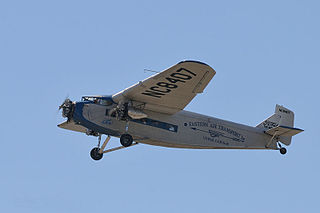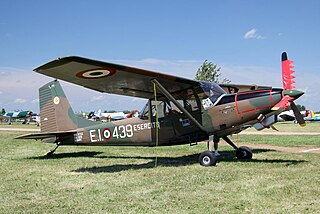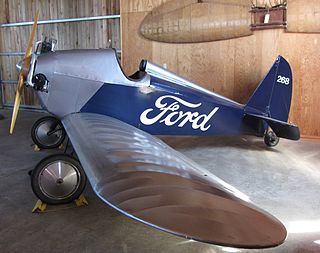
The Ford Trimotor is an American three-engined transport aircraft. Production started in 1925 by the companies of Henry Ford and ended on June 7, 1933, after 199 had been made. It was designed for the civil aviation market, but also saw service with military units.

The Avro 691 Lancastrian was a British and Canadian passenger and mail transport aircraft of the 1940s and 1950s developed from the Avro Lancaster heavy bomber. The Lancastrian was basically a modified Lancaster bomber without armour or armament and with the gun turrets replaced by streamlined metal fairings, including a new nose section. The initial batch was converted directly from Lancasters; later batches were new builds.

The Rutan VariEze is a composite, canard aircraft designed by Burt Rutan. It is a high-performance homebuilt aircraft, hundreds of which have been constructed. The design later evolved into the Long-EZ and other, larger cabin canard aircraft. The VariEze is notable for popularizing the canard configuration and moldless glass cloth composite construction for homebuilt aircraft.

The British Aerospace Jetstream 41 is a turboprop-powered feederliner and regional airliner, designed by British Aerospace as a stretched version of the popular Jetstream 31. Intended to compete directly with 30-seat aircraft like the Embraer Brasilia, Dornier 328 and Saab 340, the new design eventually accommodated 29 passengers in a two-by-one arrangement like the Jetstream 31. Eastern Airways of the UK is the biggest operator of Jetstream 41s in the world, with 14 in the fleet.

The Antonov An-10 Ukraina is a four-engined turboprop passenger transport aircraft designed in the Soviet Union.

The Cessna 414 is an American light, pressurized, twin-engine transport aircraft built by Cessna. It first flew in 1968 and an improved variant was introduced from 1978 as the 414A Chancellor.

The Saunders ST-27 was a regional aircraft built in the 1970s by the Canadian Saunders Aircraft Company based at Gimli, Manitoba. The aircraft was designed as a conversion of the earlier de Havilland Heron. The conversion program was extensive and featured two Pratt & Whitney Canada PT6 turboprops and a stretched fuselage. Despite its promise as a regional airliner, the project collapsed when Manitoba government funding was withdrawn in 1976.

The PZL-105 Flaming (flamingo) is a Polish short-takeoff-and-landing (STOL) utility aircraft designed by PZL "Warszawa-Okęcie". It remained a prototype.

The Fokker F.IX was an airliner developed in the Netherlands in the late 1920s, intended to provide KLM with an aircraft suitable for regular services to the Dutch East Indies. When the onset of the Great Depression forced the postponement of those plans, the market for this aircraft disappeared as well, although it did see military service in Czechoslovakia as a bomber.

The Fokker F.25 Promotor, first flown in 1946, was a single-engined, twin-boomed, four-seat passenger monoplane with a pusher engine mounted at the rear of a central nacelle. It was of wooden construction and has fitted with a retractable nosewheel undercarriage. One feature of the design was that instead of a 2 + 2 seating, the pilot sat in front to the left, and all three passengers were on a bench seat to the rear of him. Alternatively, when being used as an air ambulance aircraft, it could carry a patient on a stretcher, which was loaded through a hatch in the aircraft's nose. The F.25 was evocative of the pre-war G.I design.

The AS/SA 202 Bravo is a two to three-seat civil light aircraft jointly designed and manufactured by the Swiss company Flug- und Fahrzeugwerke Altenrhein (FFA) and the Italian company Savoia-Marchetti. The aircraft was designated the AS 202 in Switzerland, and the SA 202 in Italy.

The SIAI-Marchetti SM.1019 is an Italian STOL liaison monoplane built by SIAI-Marchetti for the Italian Army. It is a turboprop-powered derivative of the Cessna O-1 Bird Dog.

The Stinson SM-6000 Airliner was a 1930s three-engined (trimotor) ten-passenger airliner designed and built by the Stinson Aircraft Corporation. The SM-6000 was a high-wing braced monoplane with room for a pilot and a cabin for ten passengers. It was powered by three 215 hp (160 kW) Lycoming R-680 engines strut-mounted one each side above the main landing gear units and one in the nose. A number of variants were built mainly with improved interiors. In 1932 the Model U Airliner was produced which had low-set stub wings with an engine mounted at each wingtip.
The Renard R.30 was a prototype trimotor airliner built in Belgium in 1931. It was a strut-braced high-wing monoplane of conventional design with a fully enclosed flight deck and separate passenger compartment. One engine was mounted on the nose, while the other two were mounted on the leading edges of the wings. Construction was metal throughout, skinned in plywood and fabric.

The Stout Skycar was a series of four one-off American light aircraft of the 1930s.
The Watkinson Dingbat was a 1930s British ultralight monoplane designed by E.T. Watkinson and C.W. Taylor.

The Zenair Tri-Z CH 300 is a three-seat Canadian homebuilt light aircraft. A single-engined low-winged monoplane, the CH 300 first flew in 1977, with several hundred kits sold.

The Ford Flivver is a single-seat aircraft introduced by Henry Ford as the "Model T of the Air". After a fatal crash of a prototype into the ocean off Melbourne, Florida, production plans were halted.

The Stout 2-AT Pullman, or "Air Pullman", was a single engine all-metal monoplane that was used for early airline travel and air mail transport in America.

The Towle TA-3 was an amphibious aircraft based on the Towle TA-2.


















